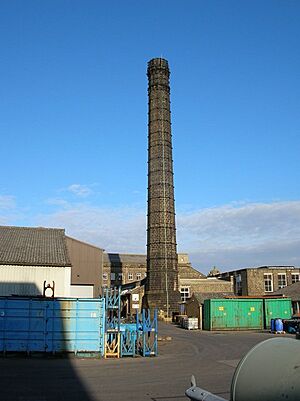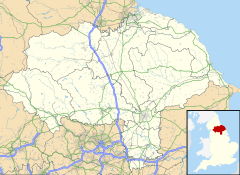Glusburn facts for kids
Quick facts for kids Glusburn |
|
|---|---|
 Chimney at Glusburn Mill |
|
| Population | 3,980 (2011 census) |
| • London | 180 mi (290 km) SE |
| Civil parish |
|
| Unitary authority |
|
| Ceremonial county | |
| Region | |
| Country | England |
| Sovereign state | United Kingdom |
| Post town | KEIGHLEY |
| Postcode district | BD20 |
| Dialling code | 01535 |
| Police | North Yorkshire |
| Fire | North Yorkshire |
| Ambulance | Yorkshire |
| EU Parliament | Yorkshire and the Humber |
| UK Parliament |
|
Glusburn is a village in North Yorkshire, England. It's found in the area called Craven. Long ago, it was part of the West Riding of Yorkshire.
The village sits near the beautiful Yorkshire Dales. It's also right on the A6068 road. Glusburn is connected to the village of Sutton-in-Craven to its south.
Glusburn is the older part of a larger area called the civil parish of Glusburn and Cross Hills. The newer part is known as Cross Hills. In 2011, about 3,980 people lived in this parish.
Contents
Glusburn's Past
Early Days of Glusburn
The village of Glusburn probably started around the 8th century. It's located just above a stream called Glus Beck. The name "Glus Beck" means 'shining stream'.
Back then, the area was wild. It had rough, uncultivated land, moorland, and thick forests. Animals like wolves, wild boar, and deer lived there.
Norman Conquest and Land Ownership
Before the year 1066, a Saxon nobleman named Earl Edwin owned most of this land. But he broke his promise of loyalty to King William I.
Because of this, the King took the land as punishment. So, in the famous Domesday Book, Glusburn was called "Terra Regis," which means 'Lands of the King'.
The Domesday Book also mentions that in Glusburn and another place, there were about 150 hectares (360 acres) of land for farming. After the Harrying of the North, all lands were taken from Anglo-Scandinavians and given to Norman Lords.
Lords and Taxes
In 1369, John Scarborough was the Lord of the Manor of Glusburn. People believe he lived at a place called Glusburn Old Hall.
Later, in the 16th century, parts of the estate were sold. Some went to John Currer of Kildwick Hall. Other parts were sold to William Garforth of Steeton.
In 1379, records show that 23 people in Glusburn paid a special tax called a poll tax to King Richard II. Sadly, in 1587, a disease called smallpox greatly reduced the village's population.
Village Life and Industry
By the end of the 17th century, Glusburn came under the rule of the vestry of Kildwick parish. This meant local church leaders managed village affairs.
Around 1700, most villagers were farmers. They also earned extra money by spinning and weaving cloth. Some people even worked as miners. A lead mine had been operating on Glusburn Moor since the 16th century.
In the late 1700s, transport improved a lot. This brought more people to the area. More houses and workplaces were built.
Growth of the Textile Industry
By the mid-1800s, many people in Glusburn worked in textile factories. Farming was often a second job. In 1851, Glusburn had 642 residents. By 1891, the population grew to 1,942, with most people working in textiles.
John William Hartley started a small weaving shed in Glusburn. John Horsfall came from Oxenhope to learn the trade with him. In 1844, John Horsfall married John William Hartley's daughter, Grace. He first became a partner and then the sole owner of the weaving shed.
His business grew very quickly. He needed more workers, so more terraced houses were built for them. The main building of the mill was built around this time. At its busiest, the mill employed 500 people.
Hayfield Hall and the Horsfall Family
John Horsfall also built a large house called Hayfield Hall. He also created the Institute and a park across from the mill. Hayfield Hall was a big country house with ten bedrooms, a garden, and a lake. The lake also served as a water source for the mill.
John Cousin Horsfall became the first Baronet of Hayfield in 1909. His son, John Donald Horsfall, was the High Sheriff of Yorkshire in 1927–28.
Hayfield Hall was sold for £1,000 in 1938 after being empty for some time. During the Second World War, it was used as an army barracks. After the war, it was taken down to make room for a mill extension.
Changes at the Mill
In the 1960s, there weren't enough workers in the area. So, the Horsfall family hired girls from Malta. A hostel was built to house them.
In 1972, Sirdar Wools Ltd bought the mill. It mainly dyed knitting wools until 1995. The mill closed down again but was bought in 1997–98 by Ellison's Holdings plc. This company made parts for cars.
Later, an American company called TransTechnology (GB) Ltd bought it. Today, it is owned by Cirteq (GB) Ltd.
Getting Around Glusburn
Early Transport Improvements
In 1773, the Leeds and Liverpool Canal was opened. This was a big step for transport. Then, in 1786, a turnpike road opened from Keighley to Kendal.
More roads followed, like the Blackburn, Addingham, Cocking End Road in 1823. These improvements brought many people to the area. More houses and workplaces were built. Six stagecoaches a day used these new roads.
In 1847, the Kildwick and Cross Hills railway station opened. This had a huge impact on the village. It also marked the end of the stagecoach era.
Buses and Modern Roads
In 1905, Ezra Laycock bought the first bus in the area. It helped people from Cowling and Glusburn get to Kildwick and Cross Hills railway station. This was the first bus service of its kind in the North of England.
In 1924, bigger companies took over the bus routes. These included Yorkshire Road Car Company and the Burnley, Colne & Nelson Joint Transport.
Today, the old Keighley to Colne Turnpike road is the busy A6069 road. It often has heavy traffic, including many large trucks. Buses serve the middle of the village. They travel between Keighley and Skipton, going through Sutton-in-Craven and Cross Hills. Another bus service goes over the Pennines to Colne and Burnley.


